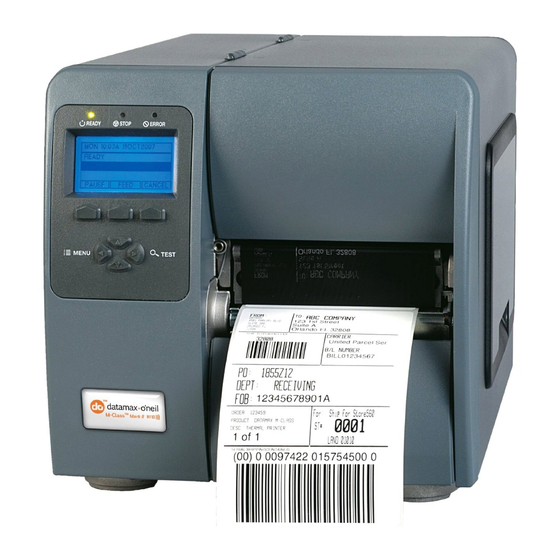
Datamax M-Class Mark II Quick Start Manual
Rfid option
Hide thumbs
Also See for M-Class Mark II:
- Operator's manual (100 pages) ,
- Maintenance manual (94 pages) ,
- Manual (10 pages)
Advertisement
Quick Links
Advertisement

Subscribe to Our Youtube Channel
Summary of Contents for Datamax M-Class Mark II
- Page 1 92-2450-01 Rev.F RFID Option...
- Page 3 20cm from printer extremity. • Any changes or modifications to this RFID module not expressly approved by Datamax-O’Neil Corporation will void the user’s authority to operate the equipment. • Operation is subject to the following conditions: (1) this device may not cause interference, and (2) this device must accept any interference, including interference that may cause undesired operation of this device.
- Page 4 Start with the Right Media Use RFID media that meets the specifications required by the encoder type: Smart Label and Tag Requirements HF Media Layout UHF Media Layout Forward Forward Movement Movement Definitions Dimension Designator Description Inches Millimeters Label Width 4.00 101.6 Label Lengths...
- Page 5 Set the Printer RFID default settings (listed below by encoder [MODE] type) can be modified via the Control Panel: HF RFID Default Settings (MODE = HF): RFID POSITION = 1.1 TAG TYPE = ISO 15693 RETRY ATTEMPTS = 3 ...
- Page 6 Encoded RFID data can also be exported to a host device by enabling OPTION FEEDBACK. This data is contained in the format <A;B;C;D;E;F>[CR] where: Is the device type: R = RFID; and, S = Linear Scanner. Is the resulting status: C = label complete; F = faulted (failed) label; and, U = unknown. Is the number of expected reads for bar codes or tags, given in two characters.
- Page 7 Calibrate the Media RFID Calibration automatically establishes the critical tag to transducer distance and power setting for the media. Before calibrating, ensure that the following prerequisites have been met: • RFID media is installed; • The Media Sensor is adjusted and calibrated for the installed media; and, •...
















Need help?
Do you have a question about the M-Class Mark II and is the answer not in the manual?
Questions and answers